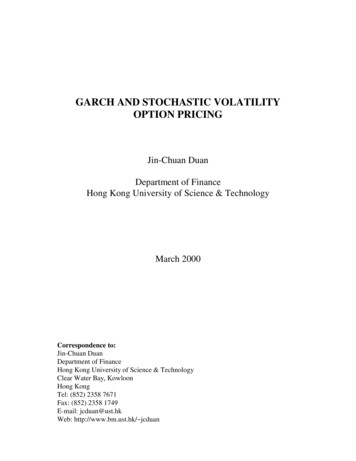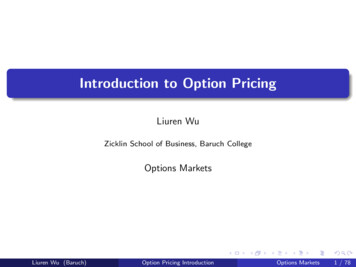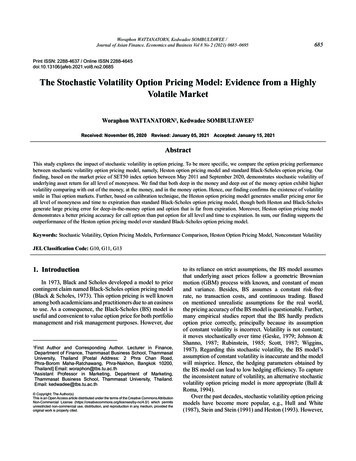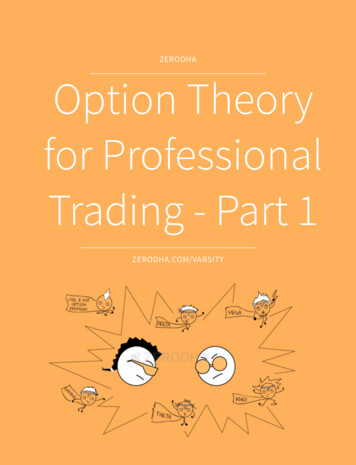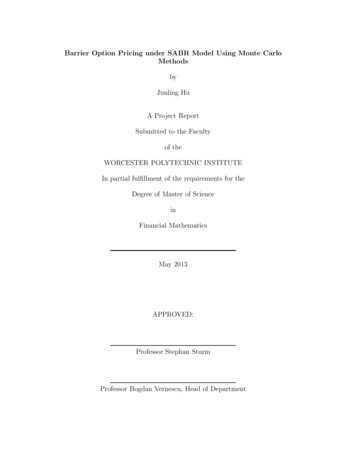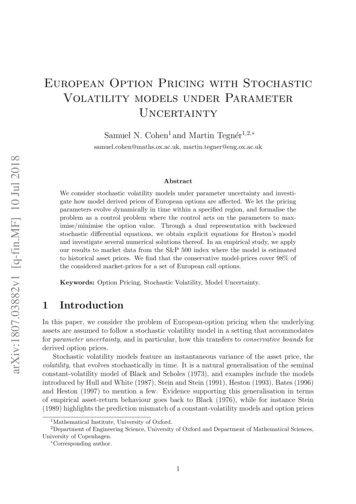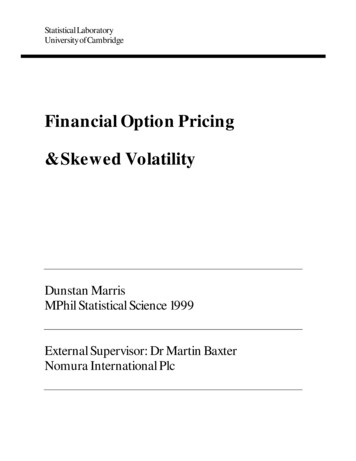
Transcription
Statistical LaboratoryUniversity of CambridgeFinancial Option Pricing& Skewed VolatilityDunstan MarrisMPhil Statistical Science 1999External Supervisor: Dr Martin BaxterNomura International Plc
SummaryDerivatives are financial products whose value depends on the state of other financialinstruments. Their price can be shown to depend on the volatility of the underlyinginstrument. Section 1 discusses current market practice and section 2 provides an overview ofprobabilistic modelling techniques.In 1998, Nomura International Plc identified an increasing change in Japanese interest ratemarkets causing a phenomenon known as "Skewed Volatility". There exist models capable ofpricing derivatives within such an environment, but these lack the tractability of commonsimpler models. This provided the motivation to search for new alternatives.This project, supported by Dr Martin Baxter, a Nomura fixed income quantitative analyst,develops derivative pricing models that reduce known deficiencies in current practice. Themain discovery, a new model, is detailed in section 3. It incorporates a single additionalparameter to describe "Skew" and exhibits closed form solutions for many derivatives. Section4 discusses implementation issues such as statistical calibration and a method to reduce"Skewed Pricing Risk" through hedging. The change in Yen markets increased to extremelevels during the first half of 1999, and motivated the incorporation of the model in NomuraInternational's analytic library.Other opportunities to employ the techniques are also investigated. Some markets such asForeign Exchange show a phenomenon known as "Volatility Smile". A framework forapplicable models is developed in section 5, though no closed form solutions are found.Section 6 looks at the statistical calibration of a model exhibiting "Smile".Extensive use is made of the MPhil in Statistical Science courses in Stochastic Calculus,Advanced Financial Models, Advanced Probability and Monte Carlo Statistics. Research wasperformed using the prodigious library facilities throughout Cambridge: Pure Mathematicsand Mathematical Statistics Library, Marshall Library of Economics, Judge Institute ofManagement Studies Library and the Cambridge University Library. Personal computingfacilities proved adequate: Microsoft Excel provided a flexible workbench, while Visual C was used to build models. The report was produced in Word.I
II
AcknowledgementsThanks are due to Dr Martin Baxter and Nomura's Fixed Income Quantitative Group, whosuggested and supported the project. Thanks also goes to the Statistical Laboratory, itsmembers and their lectures.Contents1Introduction .42Martingale Machinery.93Shift Model . 144Skew Pricing Methodology.325Non Linear Models.446Smile Pricing Methodology.56Concluding Remarks.58Appendix.60Bibliography.72III
1 IntroductionFor over 100 years, financial markets have traded derivative products whose worth dependson the price of an underlying stock. Numerous models of markets and stock prices have beendeveloped to determine the fair value of such derivative products.In 1900, Bachelier proposed a stock model that became known as Brownian motion. Einsteinand Wiener later developed the modern mathematical version. By 1965, Samuelson studiedstock prices through geometric Brownian motion. For three-quarters of a century thesemodels proposed that the value of derivative products depended on a holder's riskpreferences.In 1973 Black and Scholes proved that in stylised market a derivative product can bereplicated by continuously trading the underlying stock, thus showing there to be a unique fairprice independent of risk preferences. Their work now forms the foundation of the derivativesindustry. This section first details the assumptions, problems and practices associated withtheir model, then briefly lists some alternative approaches.1.1 Black Scholes AssumptionsThe Black Scholes methods have been and applied to derivatives based on many underlyingproducts. The fundamental assumptions are unchanged, and are well catalogued by Hull[1997]:The underlying instrument follows the stochastic process:dS t µS t dt S t σdWt , indexed from the spot trade S 0The short selling of securities with full proceeds is permittedThere are no transaction costs or taxesAll securities are perfectly divisibleThere are no riskless arbitrage opportunitiesTrading is continuousThe risk free rate of interest r is constant and the same for all maturitiesThe canonical example is the European call, giving the purchaser the option to buy theunderlying instrument at the end of the option's life span, t T , at a strike price K . Theseassumptions lead to an analytic solution for the price P0 from five parameters:P0 BS EuroCall (S 0 , K , T , r , σ )4
In practice r and σ may change over the life of the option and a form of expected averagemay be used instead. Bond markets provide values for such r , but σ is difficult to calculategiven past data and is open to significant future speculation. See the historic volatility graph inFigure 1-1.This leaves S0 , K , T , r directly observable, while σ can be calculated by observing the marketconsensus on P0 , and inverting the Black-Scholes formula1. The estimate obtained is knownas "Black Scholes implied volatility", denoted here by σ Implied . Figure 1-1 also graphs Impliedvolatility, and one can see the market has come to a more stable consensus on the meanvolatility for the period.Figure 1-1 Historic and Implied Yen VolatilityUnfortunately P0 varies in a complex fashion on S0 , K , T , r , making it awkward to spotexpensive or cheap prices. Hence, prices are often quoted in terms of σ Implied from which P0can be generated as required by accounting software.1.2 Black Scholes ProblemsDespite the success of the Black Scholes model, options often trade at other prices than itpredicts. Anomalies are monitored through the break down in the Black Scholes assumptionthat σ Implied should be identical for all options on a given underlying instrument for a givenexpiry.1 The formula has no analytic inverse, but is monotone for European Options. Shaw [1998] graphicallydiscusses the break down in monotone behavior, and thus degeneracy of the inverse, amongst warrantsand barriers. This project confines the calculation to European Options, so is able to gain an inverse viaNewton Raphson numerical approximation, supported by Bisection method upon non-convergence. SeePress et al [1992] for algorithm.5
To discuss volatility for a specific group of options this report uses σ ImpliedK S 0 ,etc. Most optionsare sold with a strike price equal to the current forward price, K FT , known as "At theMoney" (ATM). The value σ ImpliedK FTis thus easily observed and shortened to σ Black Scholes .ATM VolatilityσBlack ScholesFigure 1-2 Implied volatility for options on JPY/USD FXFuture, 46 days to expiry, Future at 83.17, ATM volatility11.44%.The anomalies imply: σ ImpliedK σ Black Scholes , K , see Figure 1-2. Many reasons have beenproposed. Some are based on the assumption Black Scholes is correct:Excessive fear of market crashes would explain the sudden appearance ofanomalies in equity options after the 1987 crashThe timing of trades in a derivative and its underlying may differsubstantially. Thus the calculation of implied volatility, using traded prices,may be incorrect. These discrepancies can empirically cause such anomaliesOthers assume market forces are finding correct equilibrium prices, and that the BlackScholes assumptions are incorrect:Black Scholes assumes the underlying process follows a log normaldistribution. Most empirical studies find reason to reject this. Anecdotally:“Log normal distributions imply 1987 style market crashes should only occurevery 1000 years” Other distributions can be used to create models thatclosely fit option marketsMarkets have transaction costs, liquidity issues and trade discretely withprice jumps. Models that include these factors can also fit some marketphenomenaVolatility evolves stochastically over time and cannot be represented by anexpected average. The process of the volatility can be estimated and modelsthat do so can closely replicate market pricesUnfortunately, no model includes captures all these facets, and those providing even a singlecorrection (two-factor models) become much less tractable and must be solvedcomputationally.6
1.3 Market PracticeThe visibility of liquid markets ensures all market participants know option "values". Hence,trades of liquid options are priced by statistical observation of market values, generatingσImplied. Black Scholes can then be used safely for all accounting purposes.Problems arise with illiquid trades. Examples include European call options with K FT ,known as far "Out of the Money" (OTM), or K FT deep "In the Money" (ITM). Otheroptions are traded "Over the Counter" (OTC) and are tailored to customers needs. They mayhave unusual life spans or more complex returns ("Exotic Options").A common solution is to fit trend lines to observed σ Implied , effectively interpolating prices overstrike and expiry ranges. These interpolated volatilities are also used within Black Scholesstyle formulae for specific exotic options.Dumas et al [1996] highlight several issues with this practice. A false sense of security can begenerated through over fitting the market observed data. Empirically the σ Implied structurechanges rapidly and endangers hedging strategies and risk analysis.1.4 Moving ForwardThe desire for consistent hedging strategies and market realistic risk analysis is forcinginstitutions to look for more sophisticated models.One might be tempted to statistically observe asset price distributions and use these togenerate derivative prices. However, as detailed in section 2, the construction of fair andarbitrage free prices requires the specification of a replicating trading strategy. The strategy isa continuous process and is closely linked to the asset price evolution, thus requiring themodel to define the asset's stochastic process.There is significant empirical data to recommend asset price models with stochastic volatility.Timeseries analysis of underlying instrument prices reveal:Bunching of high and low volatility episodes, known as "Volatility clustering"Volatility is correlated with information arrival, hence varies according toseasonal effects such as holidaysVolatility regresses to mean levels with oscillations above and below7
Unfortunately, even approximated stochastic volatility models, such as the auto regressiveGARCH family, are mathematically awkward. Although solutions are known for commonderivatives, they can be extremely time-consuming frameworks for the development of newexotics and risk analysis. Furthermore solutions are computationally expensive to achieve,and sometimes rely on less stable numerical methods such as Monte Carlo integration.This project aims to find mathematically tractable models, based on the Black-Scholes model,that fit market observed prices. It is believed they can fill some roles in pricing and riskanalysis while minimising mathematical requirements.1.5 Model TractabilityThere are some important requirements and measures of mathematical tractability. Onerequires models that are fast to adjust for new products and fast to solve for individual trades.The first requires mathematical tractability, the second ideally requires analytical solutions ormodels that give rise to formulae suitable for fast numeric integration.1.5.1 Model and Claim IndependenceIdeally, models should have no link from a specific contract to the model of the underlyingprocess. This makes economic sense, since the underlying process is an independentlyobservable and possibly tradable entity. See Figure 1-3.UnderlyingProcessProductContractPresent ValueFigure 1-3 Modeling Information FlowThis aids extension of the model to more complex contracts. A counter example is thedeterministic volatility structure approach. The underlying process is adjusted according to anoption contract's strike value. This causes problems with path dependent exotics, such asbarriers, look-back and Asian options.1.5.2 Single Source of Random PerturbationsModels of the underlying process driven by numerous diffusions become analytically difficultto manipulate, statistically difficult to fit and numerically hard to solve.8
1.5.3 Low Markov DimensionDiffusion models are analogous to continuous time Markov chains. This link becomes explicitwhen models are discretised. The Markov dimension is defined as the number of state spacevariables required modelling the process. For example:If volatility and price evolve separately it is a two dimensional modelIf historic values are required for future steps, they can be stored in separateMarkov dimensions. Thus GARCH models have Markov dimension greaterthan one.Low dimension models are faster to manipulated analytically and numerically.2 Martingale MachineryBlack Scholes derivative pricing theory relies on the construction of risk free claim-replicatingstrategies. For example European options have claims that can be replicated in a risklessmanner by continuously managing a portfolio of two assets, the underlying instrument andany other instrument, known as a numeraire, see Baxter and Rennie [1996].In 1976, Cox and Ross observed that for certain stock models arbitrage free derivative pricescould be calculated as a form of expectation of the claim. This probabilistic approach obscuresthe replicating strategy, but aids the application of Black Scholes to other models of theunderlying instruments. In 1981, Harrison and Pliska proved a rigorous connection betweenarbitrage free markets and the set of stochastic processes known as martingales.This section aims to outline the important arguments for subsequent development of newmodels.2.1 MartingalesStochastic processes, {S t }t 0 , are useful models of fluctuating assets. One can construct aprobability space (Ω, ℑ, Ρ ) as follows: Let S (ω ), ω Ω be a potential path of the asset, andΡ(ω ) be the probability it takes such a path. Thus S t is a random variable taking possibleasset values at time t 0 . Generate a filtration of sigma fields describing the informationknown about the path by time t 0 : ℑt σ (S s : s t ) .Investors are usually assumed risk adverse and not interested in holding a risky asset unlessthey expect to gain wealth. Thus one expects market equilibrium to yield prices that obey thefirst inequality below:9
Ε Ρ [S t ℑ s ] S s , s t and Ε Ρ [ S t ] , tThe right-hand inequality is a technical condition, and together they form the definition of asub-martingale. Furthermore, it is sometimes possible to construct a new probability measure Ρ such that:Ε Ρ [S t ℑ s ] S s , s t and Ε Ρ [ S t ] , t whence the process is called "martingale with respect to the measure Ρ ". If the measures areequivalent, i.e. Ρ(A ) 0 Ρ(A ) 0 , Ρ is called an equivalent martingale measure. 2.2 Market ModelsA portfolio of the financial instruments may be traded such that they approximate the worthof a derivative's pay-off. This is known as hedging, and is easily studied in stylised discretefinite markets. It is possible to show there is a hedge that will minimise the expected squarereplication error.Furthermore, in some stylised markets some derivatives are exactly replicable, and are called"attainable". If all claims within a market are attainable, the market is called complete.If a party were to trade attainable derivatives at a value different from the cost of replicationthen there would be an opportunity for others to earn risk free money. This is not a realisticsituation, and by adding the assumption there is never any such opportunity ("no arbitrage")one gains a strong modelling framework. Harrison and Pliska [1981] show an importantconsequence:The market is arbitrage free if and only if there is at least one equivalent martingalemeasureIf so, the market is complete if and only if the measure is unique2.3 Choosing ModelsCombining ideas from the previous two sections, one wishes to find stochastic models ofassets that imply complete markets, and thus one must find processes for which there existequivalent martingale measures.10
The classic Samuelson and Black Scholes choice of geometric Brownian motion fulfils thiscriterion. Girsanov's theorem provides a method of constructing the new measure. However,this project discusses alternative processes.Harrison and Pliska highlight that process continuity and the Markov property are neithersufficient nor necessary conditions for asset processes to yield complete markets. If twoprocesses are identical except for their probability measures, either both or neither arecomplete. This leads to an assertion that only the null sets of the distribution of {S t }t 0 arerelevant to market completeness, and:"Thus the parts of probability theory most relevant to the general question[what processes yield a complete market] are those results, usually abstractin appearance and French in origin, which are invariant under substitutionof an equivalent measure."The ramifications are discussed later alongside proposed models.2.4 Martingale Option Pricing Assuming there exists a unique equivalent martingale measure, Ρ , for a given asset process{S t }t 0 , one can continue with the classical results of derivative pricing. Formally, options,forwards and other derivatives are contingent claims. They are legal agreements that result ina transfer of worth between two parties at a pre-specified time in the future, say T , accordingto the movement of other market observable values, say St .For the simplest derivatives the legal claim's worth, C , can be written as a function of theterminal price ST , and the contract’s strike price K . For Example:When selling a Forward of product A, one agrees to sell at a price K a fixedamount of A to the other party at time T . It is worth C (St K ) to thecounter-party.When selling a European Call Option of product A, one agrees to offer to sellat a price K a fixed amount of A to the other party at time T . The otherparty need not accept the offer at time T . It is worth C (St K ) to thecounter-party. 2.4.1 Simple NumerairesAn introductory run through is best seen when a cash bond is used as numeraire, and when such risk free bonds have zero yield. One can then construct a Ρ martingale process Et thatreplicates the claim C at time T :11
Et Ε Ρ [C ℑt ]The martingale representation theorem states there is a previsible2 process φt such that:Et Ε Ρ [C ] ò φ s dS st0Since φt is previsible, one can build a portfolio of with φt of the underlying instrument, andψ t Et φ t S t of the numeraire. The value of such a portfolio at time t is:Pt φS t ψ t 1 φt St (Et φt St ) EtIf dPt φ t dS t ψ t 0 the portfolio is said to be self-financing: Any change in value of theportfolio matches the changes in the portfolio's contents. Since Pt Et , dPt dEt ; by thedefinition of Et , dEt φt dSt giving the required dPt φt dSt . Thus Pt is a risk free selffinancing portfolio that replicates C at time T . Therefore, the arbitrage free price for theclaim at t 0 isP0 Ε Ρ [C ]2.4.2 Other NumerairesAlternatively, a numeraire that follows a process Bt can be used to form a "discountedprocess" Zt Bt 1St . As long as Zt does not violate the technical conditions above, a measure Ρ can be found to remove any drift such that Z t is a Ρ martingale. One can also constructEt that replicates the a "discounted claim" BT-1C at time T :[Et Ε Ρ BT-1C ℑt]Again the martingale representation theorem states there is a previsible process φt such that:[]tEt Ε Ρ BT 1C ò φ s dZ s20A stochastic process that is unable to see into the future: adapted and cadlag.12
Since φt is previsible, one can build a portfolio of with φt of the underlying instrument, andψ t Et φ t Z t of the numeraire. Then the value of such a portfolio at time t is:Pt φS t ψ t Bt φSt (Et φt Z t )Bt Et BtLet σ tZ be the volatility of Zt , and thus φtσ tZ is the volatility of Et . Likewise suppose thevolatility of numeraire (often zero) is σ tB . Then the stochastic calculus product rule gives:d ( Et Bt ) Bt dEt Et dBt σ tB (φtσ tZ )dtBy the construction of Et , dEt φt dZ t . Substituting gives:()dPt φ t Bt dZ t Z t dBt σ tBσ tZ dt ψ t dBtRecognising that dSt d (Bt Z t ) Bt dZ t Z t dBt σ tBσ tZ dt , and substituting gives:dPt φ t dS t ψ t dBtProving Pt is a risk free self-financing portfolio that replicates C at time T , and so thearbitrage free price for the claim at t 0 is[Pt B t Ε Ρ BT-1C ℑt]2.5 Example Derivatives2.5.1 Interest Rate Caplets3Choose a zero coupon bond maturing on the caplet payment date, price P(t , T ) , as thenumeraire. Assume this martingale under ΡT the " T forward measure". One can define the(forward) Libor rate:3See Appendix A.7 for a discussion on Caps and Caplets13
Lt 1 æ P(t , T δ ) öç 1 δ çè P(t , T )øSince P (t , T ) is a martingale under ΡT , it follows Lt is a ΡT martingale. Thus an option onLT struck at K paid at T (known as a caplet) has a present value:[](P0 P(0, T )E ΡT (L K ) P(0, T )BS L0 , K , σ 2 , T )2.5.2 Foreign Exchange OptionsLet C t be the quantity of domestic currency required to purchase one unit of foreign currency.One can not "trade" this exchange rate. One can however purchase foreign bonds, whosedomestic value is given by:C t PFor (t , T )Again choose a domestic bond PDom (t , T ) , as the numeraire. The first discount by the secondis a martingale under ΡT , the domestic " T forward measure". That means the forward FXrate for payment at T:Ft C t PFor (t , T )PDom (t , T )is martingale. Thus the present value of a foreign exchange European call option is given by:[][Pt PDom (0, T )E ΡT (CT K ) PDom (0, T )E ΡT ( FT K ) ] PDom (0, T )BS (F0 , K , σ 2 , T )3 Shift Model3.1 AimThis section develops a new option-pricing model capable of replicating market prices thatdisplay linear implied volatility skew. The treatment is for a generic underlying asset, thoughFixed Income products commonly display these pricing trends. For example, see Figure 3-1.14
Figure 3-1 JPY 6 month Caplet, Reset 1 Yr., March 1999The model must match Black Scholes ATM prices, but differ either side by a linear amount.This suggests a single extra parameter could describe the anomaly.3.2 Previous Research3.2.1 Constant Elasticity Of VarianceShortly after Black and Scholes [1973], Cox and Ross [1976] a series of stock price processesand a framework for solving option pricing problems. Some of these SDEs fall under theConstant Elasticity of Variance model:dS t µS t dt S tα σdWt , α [0,1]This suggests σ Stα 1 , or that the volatility increases as St decreases4. Economically equityprices should become more volatile as they fall, since the corporation's total value will havedecreased with respect to their fixed costs or debt.This model induces linear skew within the (90%, 10%) Call Delta range. Setting α 1provides Black-Scholes as a sub case and other closed form solutions exist for α 0, 12 , 23 .However the general solution involves an infinite series of Gamma functions, "which is somewhat awkward to evaluate" Shaw [1998]. Monte Carlo numerical techniques5 can producesolutions for all α [0,1] . Figure 3-2 graphs the skewed implied Black Scholes volatility forCEV prices.4WhenS 0 1 , the CEV model's σ must be re-scaled for α 1 to ensure the ATM options agree withBlack-Scholes prices. An explicit formula provides the adjustment5 Discussed in section 3.4.1σCEV S01 ασ Black Scholes .15
Figure 3-2 CEV Model Implied VolatilityEmpirical studies of bond price timeseries, see Chan et al [1992], find significant evidence forvalues α 1 , while others, see Marsh and Rosenfeld [1983], find no evidence to reject the lognormal model.3.2.2 Compound OptionsIn 1979, Robert Geske provided further and more complex arguments for the equity market'simplied volatility skew. Shares in a company have a comparable income stream to theoreticallong dated options on the company's assets. Geske argues an equity option should bemodelled as an option upon an option, known as a Compound Option.Closed form solutions exist to price compound options, and company reports may provide thenecessary economical data for their pricing inputs. However there are significantdisadvantages in using non-market observable values within option pricing, and the model issignificantly less tractable than Black Scholes.3.2.3 Displaced DiffusionIn 1983, Mark Rubinstein developed an equity option-pricing model similar to Geske [1979].The firm is decomposed into a proportion α of risky asset that follows a log normal processwith constant volatility, and (1 α ) of risk free asset that provides a constant return. The firmis assumed to have a debt equity ratio of β . Ignoring Rubinstein's dividend treatment,summarising parameters are derived as a α (1 β ) and b (1 α αβ )r . Economicassumptions give the stock value as the sum of a risky process and risk free process in theproportions a and b . Discovery of an arbitrage pricing mechanism leads to a European calloption formula:[Ε aeWt S0 bS0 K] 16
resembling a Cox and Ross [1976] risk neutral Black-Scholes derivation:[Ε e z S0 K] suggesting the analytic solution as an adjustment of a Black-Scholes formula:changing PVEuroCall (S 0 , K , t , r , σ ) to PVEuroCall (aS 0 , K bS0 , t , r , σ R )Rubinstein requires the debt to be riskless, which implies a 1 , and demonstrates this toinduce one direction of skew, increasing as a decreases. Hull [1997] describes a 1 ,implying the firm's debt exceed its riskless assets, resulting in similar arguments to thecompound option model, and skew of the alternate direction. See Figure 3-3.Figure 3-3 Displaced Diffusion Model3.3 Proposed ModelThe rest of the section details a new model derived from the requirements in section 1.Although not discovered until half way through the project, it could be seen as a modern andextended version of Rubinstein [1983]. A similarity with the CEV model is found, and believedto be unpublished.3.3.1 Stochastic Differential EquationA model must describe the stochastic process of the underlying instrument. By restrictingattention to tradable instruments6 in arbitrage free markets, Harrison and Pliska [1981] inform us the process is martingale under a martingale measure Ρ . The model proposed is:E.g. Forwards. Stock processes require deterministic drift undermartingale.6 Ρ , such that their discounted process is17
dS t (βS t S 0 (1 β ))σ Shift dWt Where Wt is Ρ Brownian motion. The model clearly has no additional innovation process,only one additional parameter, β , and retains a single Markov dimension. These threeproperties suggest a highly tractable and desirable model.The SDE also contains two special cases, the Normal Absolute Diffusion model and a lognormal model, similar to Black Scholes. Both have analytic and well studied solutions, and arespecial cases within the CEV model.βNormal0Log-Normal1Table 3-1 Shift Model Embedded Cases3.3.2 Log Normal DistributionsFor β 0 , let X t βS t S 0 (1 β ) , then:X 0 S0dX t βdS t dX t βX t σ Shift dWtThis has a global and unique analytical solution:( 2X t X 0 exp βσ Shift Wt 12 β 2σ Shiftt)So:ST ( ())S0 2exp βσ ShiftWT 12 β 2σ ShiftT (1 β )β18
The terminal prices, S T , follow a displaced log normal distribution7, and since X t 0 itfollows S t S 0(1β) 1 . This gives numeric insight into the model: by displacing theminimum below zero the instrument will fluctuate more than normal at low values.Figure 3-4 shows probability density functions of ST for the Shift and Black Scholes models.Although not visible at this scale, the probability the Shift model price will be negative is oforder 10 7 when σ 20% .Figure 3-4 Price DistributionS 0 1 σ Shift 20%A call option far OTM will only enter the money if there is a large increase in the underlying,thus its value depends only on the right hand tail: the thicker the more valuable. Far OTM putoptions are similarly only effected by the left tail (see Hull [1997]). Thus the Shift modelshould display skew relative to Black Scholes log normal prices.When β 0 the substitution method fails. However this is the absolute diffusion model and()the distribution is easily calculated as S T S 0 1 σ ShiftWt , and shown in Figure 3-5. Thesubstitution method is valid for all other values8. Two examples are given in Figures 3-6, 3-7.78This gives rise to the name "Displaced Diffusion".When β 1 the Hull arguments reverse suggesting the alternate direction of implied volatility skew.19
Figure 3-5 Distribution under Absolute DiffusionFigure 3-6 Distribution withβ 0Figure 3-7 Distribution withβ 13.3.3 DriftAlthough it is known the first moment of the price distribution, the mean, is irrelevant tooption pricing, it is interesting to see a difference emerge between the Black Scholes lognormal process and this new model. Under the original probability measure Ρ , one mightexpect:dS t µ (t , S t )dt ( βS t S 0 (1 β ))σ Shift dWtRe-arranging gives:éùµ (t , S t )dS t
as "Black Scholes implied volatility", denoted here by Implied σ. Figure 1-1 also graphs Implied volatility, and one can see the market has come to a more stable consensus on the mean volatility for the period. Figure 1-1 Historic and Implied Yen Volatility Unfortunately P0 varies in a complex fashion on S0,K,T,r, making it awkward to spot
